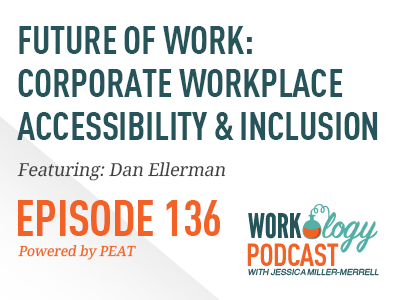According to the Amplify Accessibility Report from Accenture, people with disabilities can potentially add an additional $23 billion to the global economy. Advances in accessibility technology can help make this a reality, enabling more than 88 million of the 160 million people with disabilities to be a part of the workforce.
As part of our Future of Work series in partnership with PEAT, we wanted to explore ways technology enables people with disabilities to participate in the workforce.
Episode 136: Future of Work: Workplace Accessibility and Inclusion with Dan Ellerman
Dan Ellerman is the Inclusion and Diversity Senior Manager at Accenture. He focuses on accessibility and inclusion programs both internally at Accenture and externally with the company’s clients. Dan says that Accenture has taken a very thoughtful approach to diversity and inclusion. The organization’s commitment starts from the top with the creation of an executive accessibility council. The company and council have worked to create a global set of physical space accessibility standards for their offices, which are located in 120 countries throughout the world.
Small Changes Make the Workplace Accessible for Everyone
Accessibility is an organizational commitment and Accenture is focused on making their physical office spaces and their technology accessible. Dan says the company works closely with technologies and software like Microsoft products – especially Outlook365 – to ensure that all employees can access their tech to do their best work. Dan also shares as an example of accommodations made for an employee who had a motor impairment. For this person, punching a security code into their mobile device was extremely challenging. Working with the team member, Dan was able to find a solution using a biometric face recognition technology that allowed the employee to unlock her mobile device with her face.
Understanding Web Content Accessibility Guidelines, or WCAG, for the Workplace
Since I began working with the PEAT team, my eyes have been opened particularly in the areas of accessibility for job candidates. However, it’s equally important and critical – as we’ve seen in my recent interview with Sassy Outwater – that accessibility extends beyond the job application and into every part of the workplace.
Accessibility online is of particular importance whether it’s a career site or job application process, and tools and technologies for employees are important as well. Dan walks us through the basics of Web Content Accessibility Guidelines, or WCAG, and how they should be applied and used. Dan says being in compliance WCAG 2.0 standards is an aspirational goal. He suggests that companies research the guidelines and start small to make changes that will push them forward.
Purchasing Accessible HR and Workplace Technology
As companies implement and add more technology to their existing HR, recruiting and workplace tech stacks, having accessible technology for employees is something that Accenture and Dan take very seriously. Dan walks us through some advice for purchasing and implementing workplace technology that is inclusive and accessible to your workforce. He says the most important thing, aside from talking about and working with the technologies, is to involve your employees who have disabilities so they can make recommendations and suggestions about the types of support they need.
I love Accenture’s commitment to accessibility for their employees, customers and clients. Their executive accessibility council helps set the standard for the rest of the organization. It also helps to organize and focus the larger efforts of the organization so that people understand the expectations and the company’s commitment in this area.
Connect with Dan Ellerman on LinkedIn.
RECOMMENDED RESOURCES
How to Subscribe to the Workology Podcast
You can also click here to find out how to be a guest on the Workology Podcast.









